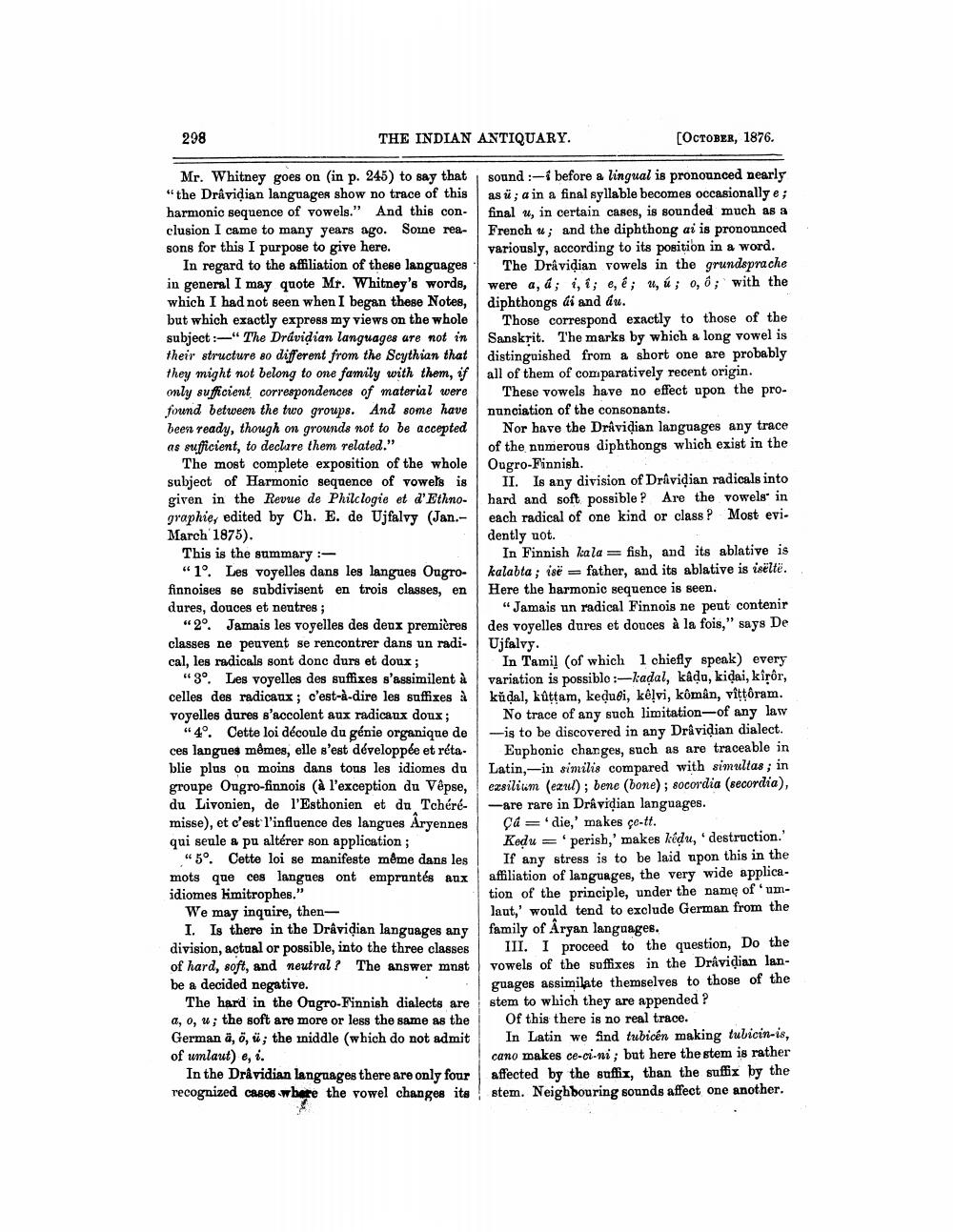________________
298
THE INDIAN ANTIQUARY.
[OCTOBER, 1876.
Mr. Whitney goes on (in p. 245) to say that sound :- before a lingual is pronounced nearly "the Dravidian languages show no trace of this asü; a in a final syllable becomes occasionally e; harmonic sequence of vowels." And this con. final u, in certain cases, is sounded much as a clusion I came to many years ago. Soine rea- French u; and the diphthong ai is pronounced sons for this I purpose to give here.
variously, according to its position in a word. In regard to the affiliation of these languages The Dravidian vowels in the grundsprache in general I may quote Mr. Whitney's words, were a,a; i, î; e, é; 2, ú; 0,6; with the which I had not seen when I began these Notes, diphthongs as and a. but which exactly express my views on the whole Those correspond exactly to those of the subject :-" The Drávidian languages are not in Sanskrit. The marks by which a long vowel is their structure so different from the Scythian that distinguished from a short one are probably they might not belong to one family with them, if all of them of comparatively recent origin. only sufficient correspondences of material were These vowels have no effect upon the profound between the two groups. And some have nunciation of the consonants. been ready, though on grounds not to be accepted Nor have the Dravidian languages any trace as sufficient, to declare them related."
of the numerous diphthongs which exist in the The most complete exposition of the whole Ougro-Finnish. subject of Harmonic sequence of vowels is II. Is any division of Dravidian radicals into given in the Revue de Philclogie et d'Ethno- hard and soft possible? Are the vowels in graphie, edited by Ch. E. de Ujfalvy (Jan.- each radical of one kind or class ? Most eviMarch 1875).
dently not. This is the summary :
In Finnish kala fish, and its ablative is “1°. Les voyelles dans les langues Ougro- kalabta; isë father, and its ablative is isëltë. finnoises se subdivisent en trois classes, en Here the harmonic sequence is seen. dures, douces et neutres;
"Jamais un radical Finnois ne peut contenir "2o. Jamais les voyelles des deux premières des voyelles dures et douces à la fois," says De classes ne peuvent se rencontrer dans un radi. Ujfalvy. cal, les radicals sont donc durs et doux;
In Tamil (of which 1 chiefly speak) every "3°. Les voyelles des suffixes s'assimilent à variation is possiblo :-kadal, kádo, kidai, kîrôr, celles des radicaux; c'est-à-dire les suffixes à l küdal, küttam, kedudi, kêļvi, kômân, vittoram. voyelles dures s'accolent aux radicaux doux; No trace of any such limitation-of any law
"4°. Cette loi découle du génie organique de 1 -is to be discovered in any Dravidian dialect. ces langues mêmes, elle s'est développée et réta. Euphonic changes, such as are traceable in blie plus ou moins dans tous les idiomes du Latin,-in similis compared with simultas ; in groupe Ougro-finnois (à l'exception du Vépse, ezsilium (exul); bene (bone) ; socordia (secordia), du Livonien, de l'Esthonien et du Tchéré- -are rare in Dravidian languages. misse), et c'est l'influence des langues Aryennes cardie,' makes çe-tt. qui seule a pu altérer son application;
Kodu = 'perish,' makes kedu, destruction.' "50. Cette loi se manifeste même dans les If any stress is to be laid upon this in the mots que ces langues ont empruntés aux affiliation of languages, the very wide applicaidiomes limitrophes."
tion of the principle, under the name ofumWe may inquire, then
laut,' would tend to exclude German from the I. Is there in the Dravidian languages any family of Aryan languages. division, actual or possible, into the three classes III. I proceed to the question, Do the of hard, soft, and neutral ? The answer mnst vowels of the suffixes in the Dravidian lanbe a decided negative.
guages assimilate themselves to those of the The hard in the Oagro-Finnish dialects are stem to which they are appended ? a, o, u; the soft are more or less the same as the Of this there is no real trace. German ä,ö,ü; the middle (which do not admit In Latin we find tubicén making tubicin-is, of umlaut) e, i.
cano makes co-ci-ni; but here the stem is rather In the Drå vidian languages there are only four affected by the suffix, than the suffix by the recognized cases where the vowel changes its stem. Neighbouring sounds affect one another.




